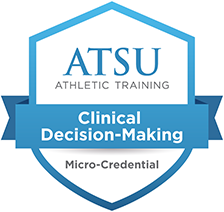Athletic training digital badges

Earning your DAT, MSAT, or Athletic Training graduate certificates now come with digital badges. Badges are visual symbols of knowledge and skills that confirm your competency and completion of a post-graduate course, graduate certificate, or post-professional degree. Badges are a digital benefit that make it easier to showcase your advanced training and competency for employment opportunities.
A badge is awarded after completing each post-graduate course. Multiple courses cumulate in a micro-credential, which can be earned in clinical decision-making, rehabilitation, orthopaedics, athletic training education, or sports neurology and concussion. And, multiple micro-credentials culminate in a degree, either a Doctor of Athletic Training or a Master of Science in Athletic Training. DAT students also earn micro-credentials in applied research and innovation.
Clinical Decision-Making is an example of a micro-credential (which is a certificate/track equivalence) that can be earned by passing the four post-graduate courses that make up the clinical decision-making foundation. A digital badge will be issued for each individual post-graduate course, as well as a digital badge for the Clinical Decision-Making micro-credential. The same can also be earned for the other athletic training certificates/tracks: Rehabilitation, Orthopaedics, Athletic Training Education, and Sports Neurology and Concussion.
DAT and MSAT alumni and current students will also be awarded digital badges.
Athletic trainers working in the digital age now have a better way to validate their education, skills, achievements, advanced training, and competencies with digital badges from ATSU. Digital badges can also be shared on social media!
Asynchronous learning format
One post-graduate course typically requires 8-10 hours per week of coursework and can be completed in 10-week blocks. Micro-credentials (graduate certificates) can be earned in as little as a year. Students will be enrolled in the same courses as the DAT and MSAT students.
In each micro-credential, one post-graduate course is offered per block.
Frequently asked questions
What is a digital badge?
Digital badges are a visual symbol of accomplishment. They’re awarded for achieving courses.
Recipients can combine badges from different sources into common collections, and when shared, these badges may be verified by any compatible system to ensure that they are trustworthy representations of their earner's experiences.
How do digital badges work?
After completing a course, you receive a digital badge, multiple badges in a given area builds a pathway to a “micro-credential.” Then, multiple micro-credentials build into a degree. Your personal ecosystem will show your personal progress through the pathways.
Badges are a visual accumulation of knowledge and skills learned during post-graduate courses. Digital badges contain metadata about achievements earned during courses, they showcase an individual’s competency and education as a verifiable achievement record.
AT badges have no expiration date. If achievement goals or curriculum of a course changes, badges may change.
How many athletic training digital badges are there?
Upon graduation from ATSU's program, a DAT student will have earned a total of 28 digital badges, five of which will be at the micro-credential level. A MSAT student will have earned a total of 13 digital badges, two of which will be at the micro-credential level. Those who pursue a graduate certificate for a micro-credential will earn a total of five digital badges.
Why should I get a digital badge?
Sharing your badges can be a great way to be recognized for an achievement or to connect with other people interested in similar badging topics.
Digital badges enable you to collect and share digital credentials that validate your skills and accomplishments. Within your digital badge pathway/backpack, you can explore a network of connected learning experiences offered by organizations you trust.
Badges are meant to be shared for you to send signals of success to the networks that matter to you, such as LinkedIn, Twitter, and Facebook.
The digital backpack enables learners to combine and connect badges from multiple sources into a meaningful learner pathways. Users can track their own progress and look ahead to plan the next steps in their learning journey.
How do I use a digital badge?
Badges are more than just an image and meant to be used in many ways. Digital badges are embedded with metadata that informs viewers of the context in which they were earned, verifying not only your education, but your competencies as well.
You can share your digital badges:
- Directly from your badge pathway backpack via a URL
- To linked social media
- As a badge for an email signature or website
- Or as a card for a resume
How do I apply?
Badge/micro-credentials students go through the same application process as DAT students. You can apply here.
To enroll in a post-graduate course, apply as a non-degree seeking student and select the track or course. If you would like to take multiple courses, you will need to re-apply for the next course.
How much is tuition for a badge?
$600 per credit plus the $32 technology fee at the individual course level / non-degree. Each course is 3 credits.
